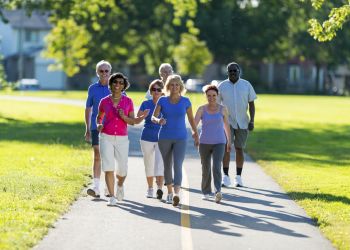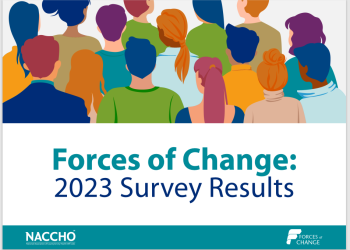By Evelyn Arana, NACCHO Health and Disability Fellow
 In recognition of February’s World Cancer Day, Evelyn Arana, one of two NACCHO Health and Disability Fellows, took some time to discuss the intersection between cancer, disability, and public health. Currently completing her doctoral dissertation on how to lower barriers related to cancer screening for women with disabilities, Evelyn explains how she first discovered this alarming health inequity and why it should be a critical consideration for local public health officials. She also provides key resources and action steps local health departments can take to ensure preventative cancer care is accessible and inclusive throughout the communities they serve.
In recognition of February’s World Cancer Day, Evelyn Arana, one of two NACCHO Health and Disability Fellows, took some time to discuss the intersection between cancer, disability, and public health. Currently completing her doctoral dissertation on how to lower barriers related to cancer screening for women with disabilities, Evelyn explains how she first discovered this alarming health inequity and why it should be a critical consideration for local public health officials. She also provides key resources and action steps local health departments can take to ensure preventative cancer care is accessible and inclusive throughout the communities they serve.
***
As a doctoral student with a research focus on reducing cancer disparities among individuals with disabilities, my dissertation explores breast cancer screening disparities among women with intellectual disabilities (ID). I first became interested in working on this topic after a remarkable internship at the Alaska Department of Health & Social Services in 2013, where I created a survey to assess the knowledge and attitudes of caregivers regarding breast cancer screening for women with ID. I learned that the majority of caregivers do not encourage their clients to have a mammogram. Other impediments to screening, as stated by the caregivers, included fear of the exam, healthcare provider pejorative attitudes, and lack of mammogram knowledge. In my dissertation, taking place in Philadelphia, I am interviewing women with ID directly to learn about their personal experiences with mammograms. The findings of my dissertation point to a number of barriers these women with ID continue to face, including communication difficulties, fear of the mammogram exam, and lack of health coordination support. These barriers may be contributing to low screening rates we see today among this population.
The Disability & Health Data System (DHDS) reports that 73.7% of women with any disability had a mammogram in the past two years while 80.7% of women without a disability had a mammogram in the past two years. This disparity is even wider when looking only at screening rates for women with intellectual disabilities. The National Core Indicators reported in 2015 that only 17% of women with intellectual disabilities received a mammogram in the past two years. Furthermore, women with any disability are more likely to be diagnosed with late-stage breast cancer and to have higher mortality, due in part to their low screening rates.
These cancer disparities go beyond that of breast cancer and also include lower screening rates for colorectal, cervical, and prostate cancer. People with disabilities continue to face barriers to cancer screening that may include inaccessibility to screening exams, preconceived notions by healthcare providers, communication barriers, and cost barriers. In addition, people with disabilities are more likely to be obese, smoke, and be sedentary, conditions that contribute to their increased rate of cancer incidence. There is a clear need for public health efforts to reduce cancer screening disparities among people with disabilities. Local health departments (LHDs) can play a fundamental role in making cancer screenings more accessible for this population.
What Can Local Health Departments Do?
Reducing disparities to cancer screening is no easy task. LHD staff should prioritize community outreach aimed at educating people with disabilities, their families, caregivers, and other stakeholders on the importance of cancer screening. To incorporate people with disabilities into their cancer disparities work, LHDs should work to improve the inclusiveness and accessibility of their resources and incorporate people with disabilities, as a part of their community needs assessment efforts.
The following suggestions can further support LHD efforts to reduce cancer disparities among people with disabilities:
- Get involved with disability organizations: Partner with organizations that work with people with disabilities in your community. Get involved with their projects, community events, and meetings. Become familiar with their resources for people with disabilities. Invite these organizations to take an active role in assessing the accessibility of your health department’s resources. Include these organizations on LHD advisory boards, evaluation teams, and planning committees. For more information view NACCHO’s fact sheet titled “Directory of Community-Based Organizations Serving People with Disabilities.”
- Ask people with disabilities to help make your LHD resources more inclusive: Invite people with disabilities to evaluate the accessibility of your health department’s resources. The disability community is diverse and has the greatest understanding of their own needs and preferences. For example, focus groups with people with disabilities may help LHDs create resources that are more inclusive and accessible. People with disabilities may also help disseminate resources across the local disability community.
- Practice multimodal communication: Provide at least one form of communication for each type of communication disability to ensure that everyone can access information. Use alternative formats for written communications, including printed documents with large text, electronic documents, and audio recordings. Learn about sign language interpreting and video remote interpreting (VRI) services for in-person communication. Become comfortable using teletypewriters (TTYs) or computers with TTY capabilities, telephone relay services, and video interpreting services (VIS) for telephone communication. Remember, communicating with people who are deaf, are hard of hearing, or have speech disabilities doesn’t have to be complicated. Simple solutions such as writing communication on paper, smart phones, or computers can be very effective. For more information view NACCHO’s recent fact sheet, “Five Steps for Inclusive Communication: Engaging People with Disabilities.”
- Invite people with disabilities to work or volunteer in your LHD: By recruiting people with disabilities, LHDs can make their efforts to reduce cancer disparities more effective, inclusive, and empowering for people with disabilities. Recruiting students with disabilities as interns or fellows can help build the next inclusive generation of public health workers that will continue to tackle cancer disparities. For more information view NACCHO’s report titled, “Strategies for Successfully Including People with Disabilities in Health Department Programs, Plans, and Services.”
Additional Resources
- NACCHO Health and Disability Webpage
- NACCHO Cancer Prevention and Control Webpage
- Women with Disabilities and Breast Cancer Screening
- The Right to Know Campaign-Breast Cancer Screening
- Chapter 3 of the ADA: “General Effective Communication Requirements Under Title II of the ADA” and its corresponding Checklist
- Leading Practices on Disability Inclusion
- Engaging People with Disabilities: Promoting Health Through Program Integration
***
The NACCHO Health and Disability Fellowship is supported by the Centers for Disease Control and Prevention (CDC), Cooperative Agreement #5NU38OT000172-04-00 and the Disability and Health program.








